

KUOW Blog
News, factoids, and insights from KUOW's newsroom. And maybe some peeks behind the scenes. Check back daily for updates.
Have any leads or feedback for the KUOW Blog? Contact Dyer Oxley at dyer@kuow.org.
Stories
-
Angry birds: Hummingbirds are cute, but they’re primed to fight
Environment
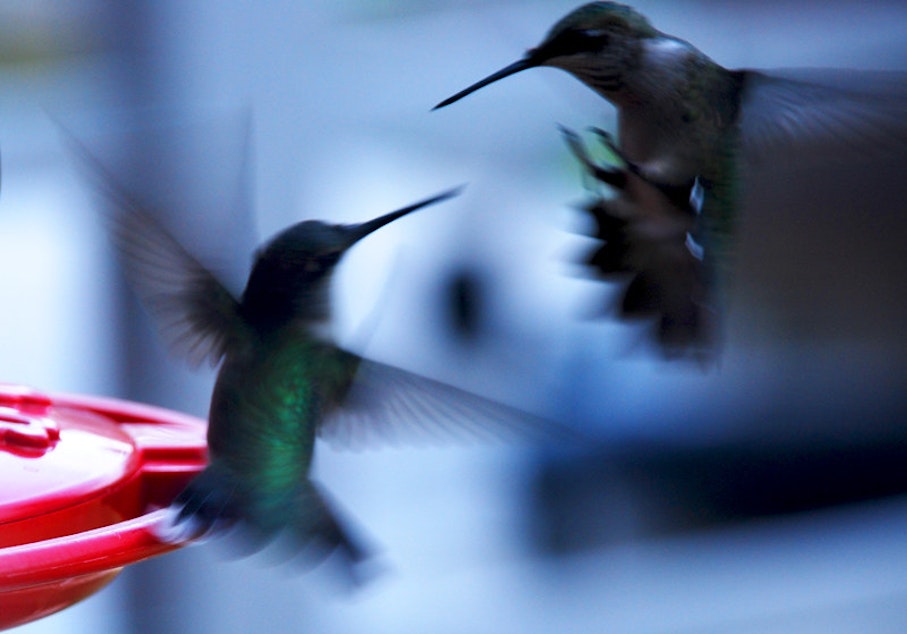 Two hummingbirds, not willing to share space at a feeder. Hummingbirds often fight or chase each other away in competition for food and territory.
Two hummingbirds, not willing to share space at a feeder. Hummingbirds often fight or chase each other away in competition for food and territory.At first, I didn't know what I was seeing — a tiny blur at the edge of a bush in Seattle's Wedgwood neighborhood, from which emitted a dramatic, high-pitched scream.
Then the scene became clear: Two hummingbirds were brawling, violently, think barroom at 1 a.m. And one was clearly losing.
Hummingbirds, I realized, are not just adorable. They're also jerks.
Yes, jerks. But don't take my word for it.
“'Hummingbirds are jerks' is a pretty good tagline for how hummingbirds operate. I use that word a lot to describe them. They fight all the time," said Alyssa Sargent, a PhD candidate at the University of Washington working in the behavioral ecophysics lab.
RELATED: UW researcher slows down hummingbirds to study them. What he found is amazing
I witnessed the ultimate victor bashing its foe into the ground as it held on with its feet, stabbing its competitor with its needle-like beak the entire time.
It was a sobering moment. Should I have broken up the fight? Perhaps offered each bird complimentary nectar and let them chirp out their woes until they calmed down?
"Trying to break up a hummingbird fight, you’d be fighting a losing battle there," Sargent said.
Sure, hummingbirds are renowned for their beauty and rapid, graceful flight. They are a treat in any garden and are generally greeted with joy.
Continue reading » -
City could tear down dangerous vacant buildings under Seattle Mayor Harrell's emergency proposal
Government
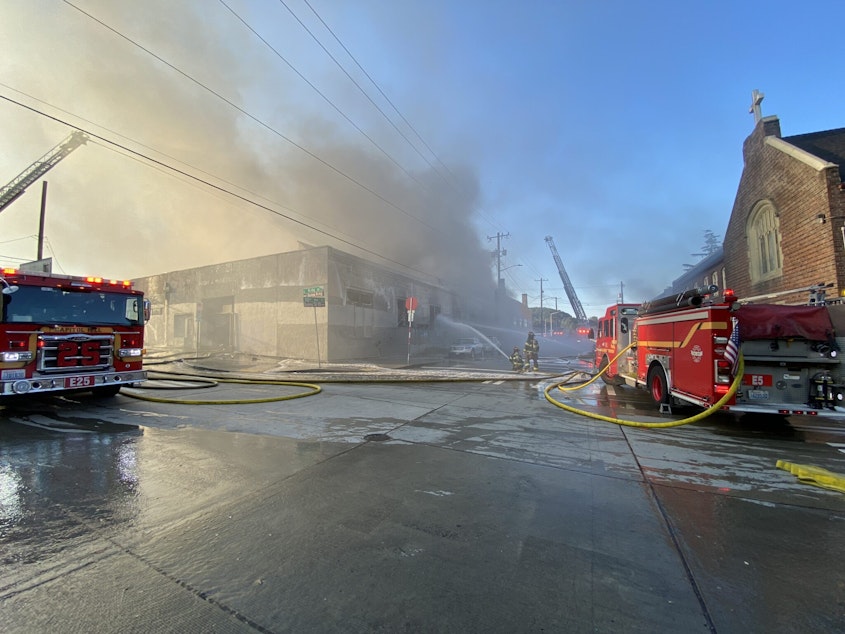 Seattle fire crews respond to a two-alarm fire at a vacant warehouse in the 1000 block of South King Street on July 20, 2023.
Seattle fire crews respond to a two-alarm fire at a vacant warehouse in the 1000 block of South King Street on July 20, 2023.The city of Seattle would be allowed to demolish unsafe vacant buildings to prevent them from catching fire under emergency legislation proposed by Mayor Bruce Harrell.
There were 130 vacant building fires reported in Seattle last year, three of them deadly. There have been 30 more such fires so far this year.
RELATED: E-bike fires are sparking trouble in Seattle. Here's how to use them safely
“While the city has taken steps to encourage adaptive reuse of vacant structures for new purposes, we cannot allow these unmaintained structures to put lives and property at risk from trespassers, arson, and other crimes,” Harrell said.
If owners of dangerous buildings don’t secure or demolish them when ordered to do so by the fire department, the city could take those steps itself and put a lien on the property for reimbursement under the proposed law change.
“This legislation will give the Seattle Fire Department a new tool to take quick action to remedy derelict buildings that threaten the health and safety of our neighborhoods,” Harrell said.
The Seattle Fire Department is already tracking more than 40 vacant buildings that could be affected by the proposed law, and estimates it could take action on about 10 buildings a year.
On New Year’s Day, a three-alarm fire in a First Hill vacant building forced the evacuation of a neighboring apartment building. There had also been a three-alarm fire in the same building in 2022.
Fire officials say one factor contributing to the city’s 69% increase in derelict buildings catching fire between 2013 and 2021 is the growing number of homeless people who use the buildings for shelter. Fires lit to keep warm — or to smoke fentanyl and meth — can spread.
RELATED: Investigators sound alarm over string of Seattle fires and
Continue reading » -
Here's why car insurance just jumped nearly 25% in Washington state
Business

If you have a car insurance policy in Washington state, you may have noticed that it's gotten much more expensive this year.
In a recent article in The Seattle Times, reporter Victor Whitman shared the stories of Washington drivers who saw their insurance premiums jumping hundreds of dollars. This comes after the state's insurance commissioner approved a bigger than usual increase to average auto premiums in Washington, nearly 25%.
RELATED: Both hands on the wheel, Washington drivers. Your insurance rates are about to jump 24%
So what's going on with auto insurance? Why are we on this rocket ship?
To find out, Soundside sat down with Kenton Brice, the president of the Northwest Insurance Council, a trade group funded by insurers.
While there are many reasons why insurance premiums have risen so dramatically, the simplest answer is that it's just much more expensive to fix vehicles today.
"It used to be that if you got in a fender bender in a parking lot, replacing the bumper of your vehicle might cost $1,500," Brice said. "That same bumper today has sensors and cameras and so forth in it and can cost thousands of dollars to replace."
So, while there's no question that the complexity and technological advances of modern cars have made driving safer, they're also much more expensive to fix.
Another big factor is the number of people on the roads. That plus the feeling of safety in a tech-heavy modern vehicle means that people are getting into increasingly worse wrecks.
"So cars are safer, they have a lot more technology that helps prevent injuries. But people are maybe taking advantage of those or don't know how those safety features work," Brice explained. "So they're driving faster, they're driving angrier, and the crashes that they're getting into are more severe."
You can listen to the entire conversation with NW Insurance Council president Kenton Brice by clicking the play button above.
Continue reading » -
More aboard! Activists, officials disagree about how to boost Amtrak Cascades ridership
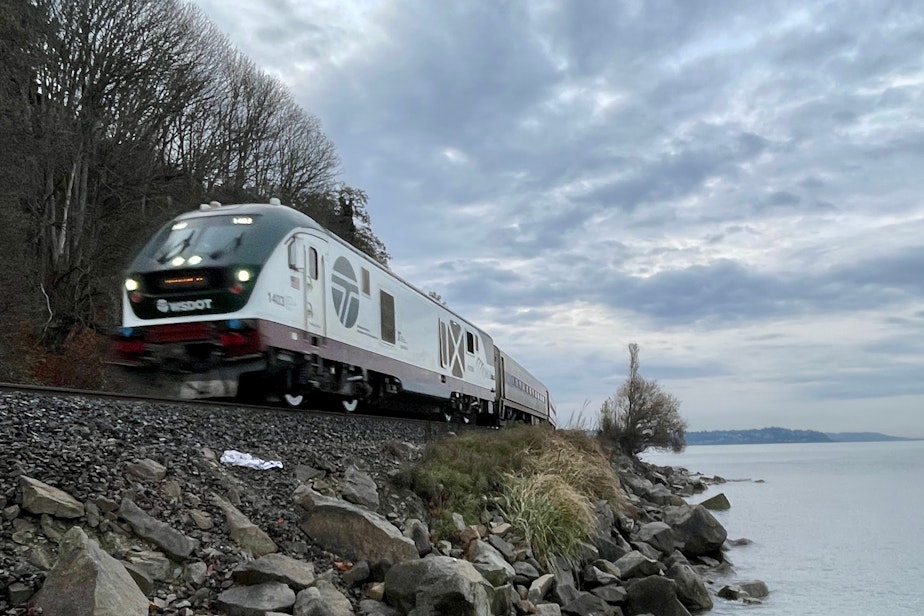 The Amtrak Cascades heads north in Shoreline, Washington, on Nov. 30, 2023.KUOW Photo/John Ryan
The Amtrak Cascades heads north in Shoreline, Washington, on Nov. 30, 2023.KUOW Photo/John RyanOfficials and climate activists disagree about the best way to get more people on board passenger trains between Oregon and Canada.
Ridership on the Amtrak Cascades, running between Eugene, Oregon, and Vancouver, British Columbia, has not returned to pre-pandemic levels, though it came close in 2023.
The line served 746,000 passengers in 2023, nearly doubling its 2022 ridership and reaching 90% of the Cascades’ pre-pandemic peak of 824,000 in 2019, according to the Washington State Department of Transportation.
The transportation department, which pays Amtrak to operate the Cascades line, has been asking the public how to improve service over the next 20 years.
RELATED: Dude, where’s my train? Why freight makes Amtrak late
The feedback has emphasized faster, greener, more frequent, and more reliable trains, as well as better connections to other modes of travel at train stations.
Major employers contacted by rail officials called for faster travel times and better Wi-Fi on the Cascades line.
Retired scientist and climate activist Arvia Morris with the Climate Rail Alliance says planners aren’t taking Amtrak’s need for speed seriously.
“We do 53 miles an hour today, and in their current plan, in 20 whole years, they would get us to 58 miles an hour,” Morris said. “We just don't think that plan is good enough.”
Continue reading » -
Could a return of workers to downtown offices rescue Seattle’s ailing budget?
Business
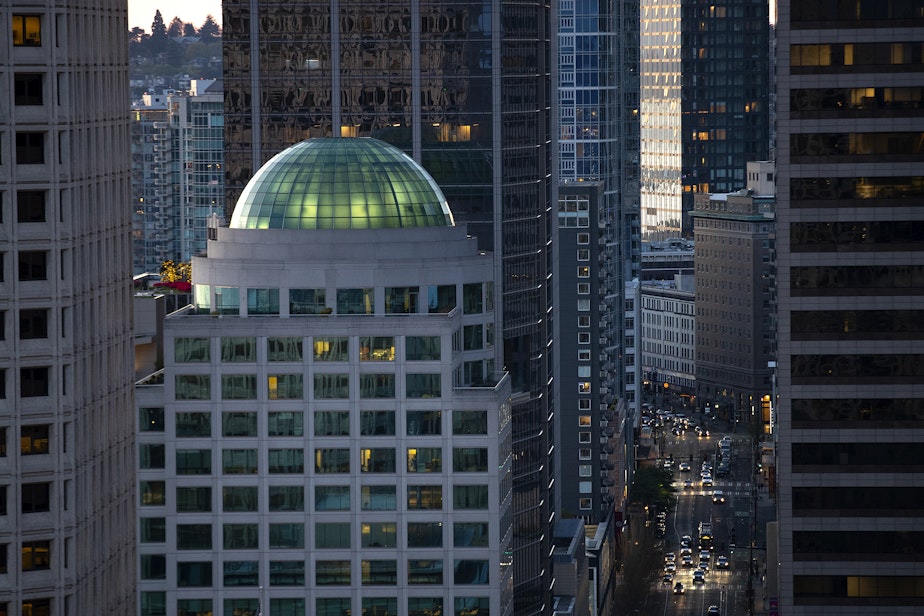 A view of downtown Seattle is shown from the Smith Tower Observatory as the sun sets on Friday, April 12, 2024.
A view of downtown Seattle is shown from the Smith Tower Observatory as the sun sets on Friday, April 12, 2024.With Seattle facing a projected $241 million budget shortfall in 2025, the City Council is looking at how Seattle got into this hole and how it might climb its way out.
A combination of record inflation and a sharp revenue drop during the height of the pandemic put the city in a financial bind, analysts told the City Council Wednesday.
Aly Pennucci, Council central staff deputy director, said that while the economic forecast looks decent in Seattle, it costs a lot more than it did five years ago to make payroll.
“The number of employees in the city hasn't increased significantly in this period, but the cost of paying for employees has increased," Pennucci said.
Much of the growth in general fund spending aside from inflation was aimed at human services, analysts said, like addressing the homelessness crisis.
Jan Duras, who leads the Office of Economic and Revenue Forecasts, told the council one thing that could help fill city coffers is more suburban workers coming back to their Seattle offices.
“The amount of tax base depends on where the economic activity takes place. So a worker that's coming to the office performing work here, rather than performing the work at home in Medina, makes a significant difference for the [business and occupancy tax] and for the payroll expense tax," Duras said.
More workers commuting into the city would also boost Seattle sales tax revenues, which took a surprise dive late last year.
Other strategies could include an early retirement program for city workers, cutting programs, combining departments, and loosening restrictions on how certain funds are spent, like revenue from the city’s sweetened beverage tax.
Correction 1:31 pm 4/19/24 - An earlier version of this story misattributed a quote by Aly Pennucci.
Continue reading » -
2023 was 'the worst year' for Anti-Jewish hate in the Northwest, Anti-Defamation League reports
 A stained glass rendering of the Ten Commandments at Sephardic synagogue, Ezra Bessaroth in Seward Park. The synagogue was established by migrants from the island of Rhodes.KUOW Photo/Anna Boiko-Weyrauch
A stained glass rendering of the Ten Commandments at Sephardic synagogue, Ezra Bessaroth in Seward Park. The synagogue was established by migrants from the island of Rhodes.KUOW Photo/Anna Boiko-WeyrauchOn Tuesday, the Anti-Defamation League of the Pacific Northwest released the results of its annual report, detailing a sharp increase in anti-Jewish harassment and vandalism. And the numbers were growing even before the Israel-Gaza War began in October.
“Unfortunately, what we saw was that 2023 was the worst year for antisemitic incidents, building on the dramatic year-over-year increases that we have already been seeing over the past couple of years,” said Miri Cypers, regional director of the Anti-Defamation League of the Pacific Northwest.
The group has published an annual audit of anti-Jewish incidents with the mission of stopping antisemitic hate since 1979.
RELATED: Washington state sees rise in anti-Arab, anti-Jewish hate incidents amid Israel-Hamas War
The numbers from last year, which show a 192% increase in anti-Jewish incidents in Washington state since 2022, also illustrate an increase in vandalism and harassment in Alaska, Idaho, Montana, and Oregon there were a total of 307 anti-Jewish incidents across the Northwest last year, up from 130 in 2022, according to the report. Washington state saw 190 total anti-Jewish incidents, including 31 acts of vandalism, one assault, and 158 reports of harassment last year.
The FBI says it’s also continuing to monitor anti-Jewish incidents and hate crimes in Washington, and also noted a rise. Though the numbers have been growing each year, FBI Special Agent Ryan Bruin said, there’s been an uptick in anti-Jewish incidents since the Israel-Gaza War began on Oct. 7.
“We've seen a marked increase in hoax bombs and active shooter threats targeting synagogues and Jewish Community Centers both in Washington state and nationwide,” Bruin said.
RELATED: After receiving racist hate mail, UW students call for action
Continue reading » -
Snoqualmie community steps up to help 4 women-owned businesses destroyed in fire
Business
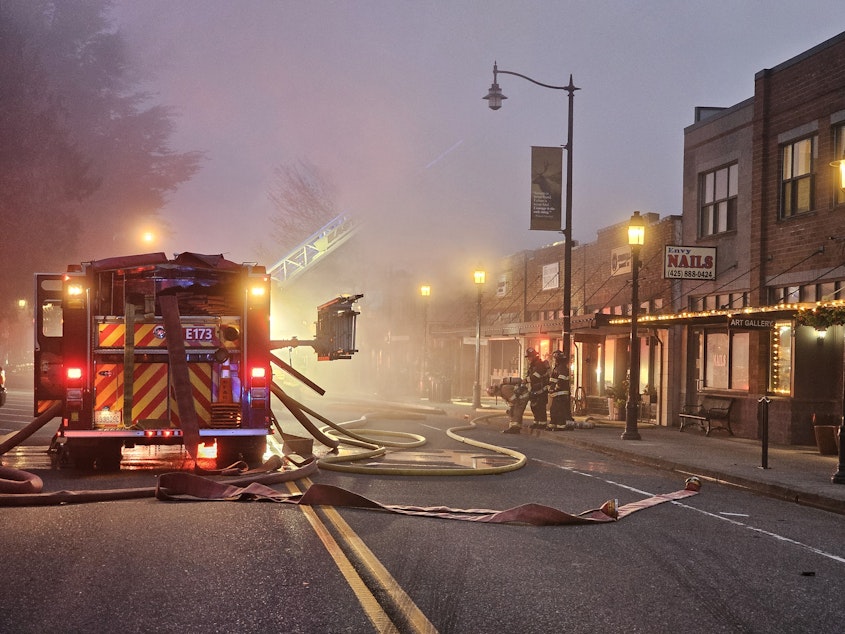 Early morning photo of 2024 large fire of building in Historic Snoqualmie DowntownJulie Chung
Early morning photo of 2024 large fire of building in Historic Snoqualmie DowntownJulie ChungA large fire destroyed four women-run businesses in a Historic Snoqualmie retail building early Sunday morning. Now the city is rallying around the business owners to help them rebuild.
Snoqualmie Ice Cream owners Heather Dean and Julie Chung are still processing the news that a fire destroyed part of the building that houses their business.
“As we go into our busy season it's a really devastating loss for us as small business owners. It's a lot,” Chung said.
RELATED: Canoeing to work: Floods bring chaos, renewal to Snoqualmie Valley
The fire was discovered during a routine patrol of the area by a Snoqualmie Police officer. The City of Snoqualmie said the most significant fire damage occurred on the back side of the building. That’s where Chickadee Bakeshop, Snoqualmie Pie Co., and Littlest Wishes Photography were located.
The SnoValley Chamber of Commerce is running a GoFundMe campaign to help raise money for the businesses impacted by the fire. So far, the campaign has exceeded its $50,000 goal by several thousand dollars.
No injuries were reported and Dean said she is thankful. “Five fire agencies responded to us, and it is a dry, 100-year-old business district. They saved the downtown,” she said.
RELATED: This story begins with a cougar eating a tiny dog in Snoqualmie
Though flames did not reach their shop, Chung and Dean lost all of their inventory and equipment.
“The smoke damage is incredible,” Chung said. “There is no way that we can operate. We're kind of thinking that it needs to be a whole remodel down to the studs, and that's going to take time.”
Chung said they are trying to find new employment opportunities for 16 employees who work at the Snoqualmie location.
RELATED: Snakes on an overpass: I-90 installs wildlife crossing near Snoqualmie
Continue reading » -
Drought emergency declared for Washington state ahead of warm summer
A drought emergency was declared for the state of Washington Tuesday, as state officials face low water supply ahead of an expected warmer-than-normal summer across the region. Seattle, Tacoma, and Everett are excluded from the emergency declaration.
"We depend on that winter snowpack to meet the needs of Washington’s farmers, fish, and communities during the dry summer months. And this year, it’s just not at the level we’re accustomed to and rely on," Gov. Jay Inslee said in a statement.
RELATED: As the Northwest spring arrives, so do anxieties over water for farming, and summer wildfires
The Washington State Department of Ecology declared the drought emergency April 16, 2024. The department makes such a declaration when the state's water supply is less than 75% of normal. Current statewide snowpack is at 68% of normal; however, regions like the Olympic Mountains are much lower. This means that streams are running lower and warmer. For example, the Dept. of Ecology points to the Chelan River where streamflow is at 52% of normal.
Caroline Mellor, statewide drought lead with the Department of Ecology, noted that Everett, Seattle, and Tacoma have strong water management strategies that make them more resilient to the drought. That is why these areas have been excluded from the emergency declaration.
"For Everett, and Seattle, and Tacoma, on those utilities that have large reservoirs, that allows them to more actively manage their water supplies," said "And they have been able to manage their supplies looking at conditions coming into the spring and summer ... and so they do not currently, nor anticipate facing any hardship for their water supplies. That's specifically for those three utilities."
By making the declaration, $4.5 million in drought-response grants will be opened up to public agencies to help mitigate complications from low water supplies. It also allows Ecology to handle emergency water right permits.
Washington state emergency drought declaration 2024
The current situation in Washington state has been long in the making. The department notes that Tuesday's declaration is "really a continuation of 2023’s drought emergency." That declaration was slated to end in June of this year; however, the recent El Niño weather pattern meant that enough rain did not fall to make up for 2023's loss.
Last winter was relatively dry. This came after Seattle was asked to conserve water in the fall due to low supply. The Seattle area then recorded its warmest December on record. Projections for summer 2024 indicate warmer than normal temperatures.
“What that actually means, in practice, is that we are facing what's called a ‘snowpack drought'," Mellor said. "A snowpack drought is different than just a regular rain or precipitation drought, because this means that most of our precipitation has come as rain instead of snow, or that snow has melted much earlier than it would in a normal year; we would expect the snow melt to happen gradually throughout spring and summer from the mountains”
“The Olympic basin is at 61% of normal for snowpack,” she said. “And North Puget Sound, that includes the North Cascades, is at 57% of normal … Lower Yakima, for that basin, they’re at 46% of snowpack. That's really concerning, because that means that water that's held in that snowpack either has already melted out to the ocean, or will be melting out a lot earlier. We are already seeing lower-than-normal streamflow conditions, as well as a clear forecast for continued or worsening streamflow conditions for April to September."
Mellor said people can expect to see streams drying up sooner than expected, especially in August. This will affect irrigation and recreational fishing.
Ecology said that many watersheds are already projecting low water supplies over the coming warm months. For example, water systems in Clallam County and Whatcom County are now trucking in water to meet demand. Mellor said Ecology anticipates that water may need to be trucked into the Olympic Peninsula this summer.
“There are clear impacts that we expect for water users and the environment across the state," Mellor said. "Specifically for agriculture, there are a number of impacts expected for irrigators and other agricultural sectors, as well as for domestic drinking water supplies, particularly for rural areas on smaller drinking water systems.”
Mellor said that drought declarations have increased over the past 10 years, since the "historically warm and dry drought of 2015." Washington has declared drought in six of the last 10 years.
"I will say, while these conditions are not as bad as 2015, we are already seeing these conditions in April. And with forecasts for warmer temperatures way above normal, and somewhat below normal precipitation, we have no expectation that these conditions will improve. We expect that they'll either stay the same or get worse in terms of drought conditions across the state."
Looking ahead, Mellor recommends that Washingtonians consider drought-tolerant plants for gardening, and using low-water-use gardening practices, like a hose timer. Also, only run dishwashers when they are full.
Continue reading » -
What's behind Molbak's return as the 'Green Phoenix Collaborative'
Business
 This is an AI generated image using ChatGPT. Organizers with Green Phoenix Collaborative feed their conversations about the project into ChatGPT and the AI program conjured up this image.ChatGPT via Parsons and Co communications firm
This is an AI generated image using ChatGPT. Organizers with Green Phoenix Collaborative feed their conversations about the project into ChatGPT and the AI program conjured up this image.ChatGPT via Parsons and Co communications firmWhen Molbak's Garden and Home ceased operations in January, it was a shock to Woodinville's green thumb community. When owners announced that the business would return, but as an entirely different operation, it came as yet another shock — and a point of confusion.
What is the "Green Phoenix Collaborative?"
"I don't mean to sound kind of, you know, overly altruistic, but it is really something that we're doing for the community," Molbak's CEO Julie Kouhia told KUOW. "We think that it is a great thing for the community. … The reason that we would do this is because people were excited about it and people wanted it to happen. And if they don't, then we won't do it.”
RELATED: Molbak's from the dead in Woodinville
Molbak's remains a business. But moving forward, it won't be a retail operation like it had been for nearly 70 years. Owners have envisioned a new business model: the Green Phoenix Collaborative. Think of the collaborative like a host of the site, allowing "partnerships" to operate there — people and organizations using the land for community gardens, event space, classes, entertainment, art events, and other gardening-related activities. It depends on who steps up to participate.
Kouhia said she wants it to be a place "where kids can get off their iPhones and come in and learn how to do something to help combat climate change."
Mobalk's plans to charge little-to-no rent for participants to operate there. It's now asking for contributions via Indiegogo to help get the collaborative up and running. Green Phoenix Collaborative aims to raise $2.5 million by May 9. It costs about $1 million to maintain the property for one year. The other $1.5 million will be put toward hiring a small team and managing a website (the collaborative wants to offer online classes and podcasts). It will also be spent to support "partnerships and prepping space for folks to cohabitate," Kouhia said, adding that she hopes to break even in the end.
Why the change?
Molbak's was a community hub in Woodinville for decades. In 2008, the business sold its property to a developer, Green Partners, with the idea that the area would be developed into something new, with Molbak's included. Green Partners became the landlord of the property, and Molbak's worked with the developer for more than 10 years on the future project. Kouhia said the result would be a model for other cities to copy, with gardening and green space between buildings.
But in late 2023, a rift emerged between the two parties. While she was tight-lipped about details, Kouhia said Molbak's wanted to build its new retail operation on a new plot, while continuing to operate on its old property. When construction was finished around 2026, the business would have moved over. After going through mediation in December, Molbak's opted to shut down its business in January 2024.
Continue reading » -
Mount Rainier visitors react to new timed entrance reservation policy
Government
 Leo Yang (center right) and his extended family at Mount Rainier National Park, April 9, 2024
Leo Yang (center right) and his extended family at Mount Rainier National Park, April 9, 2024Summer visitors to Washington state's Mount Rainier must get timed entry reservations, so they won't be turned away at the entrance gate. People are beginning to snap up available slots. So the earlier you can plan your summer visit, the better.
During warm summer weekends at Mount Rainier, lines at the entrance gate can approach three hours long. Then, like dinner passing through a python, that bolus of cars snakes its way to the overfilled parking lot at Paradise, where trails get crowded and fragile plants get trampled.
RELATED: Meteor shower casualties — Mount Rainier wildflowers
Visitors have told the park service they're fed up with the overcrowding. The new timed-entry policy is meant to space people out more.
Leo Yang is visiting Rainier from Sammamish with his extended family. He sees both sides of the issue.
"National parks should be accessible for a lot of people," he said. "So instead of people just having to make a reservation like you do at like a restaurant ... they should be able to just drive in and be able to explore."
But on the other hand, he understands that the system will help protect wildlife and reduce long entrance lines to get into the park.
"It's probably a good thing just so that we could preserve this place a little longer."
RELATED: How should park officials deal with traffic/visitors on Mount Rainier?
Michelle Thomas, who traveled with Sean Pank from Oregon, says she's cool with it.
"I'm glad we know, because I'll plan ahead, but I like planning ahead, so I'll do that," Pank said, adding that that they tend to choose unpopulated places to hike anyway, so are unlikely to be affected.
But Agnes Jurkowski from Chicago is skeptical. She says it's "not the best idea for me because I like to go with the flow, day by day. [I'm] not a really huge planner."
Continue reading » -
Puyallup Tribe to have 17 acres of waterfront land added to reservation
Government
 FILE: Dakota Case makes his way up a hill along the Puyallup River before the Puyallup Tribe welcomed the first salmon of the year with a ceremony on Tuesday, May 15, 2018.KUOW Photo/Megan Farmer
FILE: Dakota Case makes his way up a hill along the Puyallup River before the Puyallup Tribe welcomed the first salmon of the year with a ceremony on Tuesday, May 15, 2018.KUOW Photo/Megan FarmerAbout 17 acres of ancestral homeland will soon be restored to the Puyallup Tribe.
The Puyallup Tribe of Indians Land Into Trust Act transfers land along the Tacoma waterfront to the federal Bureau of Indian Affairs, allowing the Tribe to expand its reservation and access to federal benefits associated with it.
"This Act will restore the Tribe's place along Commencement Bay and will expand the Tribe's presence along the Blair Waterway," Puyallup Tribal Council Chairman Bill Sterud said in a statement. "It is truly historic for the Tribe."
RELATED: Tribes call for national ban on salmon-killing chemical in car tires
On Thursday, the U.S. House of Representatives voted 400-15 to approve the Act, which the U.S. Senate passed unanimously in December. The Act now goes to President Joe Biden's desk.
The land in question is already owned by the Puyallup Tribe, and is the site of the Tribe's new Ruston Way waterfront property. But the stretch of land has been excluded from federal trust because of "an absurd consequence of the decades of pollution brought to ancestral Puyallup lands," according to the Tribe. The land was contaminated over the years by industrial development near Commencement Bay.
RELATED: Dam owner pleads guilty after spilling turf, tire bits in Puyallup River
The Tribe was left to clean up the polluted property themselves, to bring it into "virtually pristine condition." According to the Tribe, the Bureau of Indian Affairs would not accept it into trust otherwise.
Benefits associated with the land include tax-exempt financing, discounted leasing rates, and new market tax credits, which are intended to incentivize private investments in economically distressed communities by providing investors with a federal tax credit.
Continue reading » -
To ease Seattle police shortage, city looks to speed up hiring process
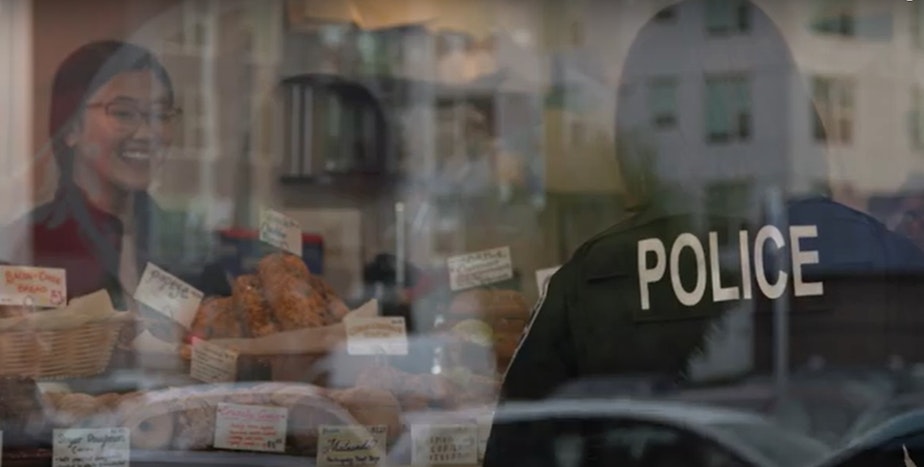 The Seattle City Council is considering an ordinance to streamline the testing process for police recruits in order to combat severe staffing shortages.Seattle Police Department recruiting video, courtesy of SPD.
The Seattle City Council is considering an ordinance to streamline the testing process for police recruits in order to combat severe staffing shortages.Seattle Police Department recruiting video, courtesy of SPD.The Seattle City Council is drafting legislation to move all the city’s police recruiting efforts into the police department itself. It’s part of an effort to ease acute staffing shortages at SPD by speeding up the testing and hiring process.
At a briefing last month Seattle Police Chief Adrian Diaz said, “We've lost 725 officers over the last five years.” He said SPD is down to about 913 trained and deployable officers — the lowest level of police staffing since the 1990s.
At a committee meeting Thursday, Council President Sara Nelson blamed the previous council majority for what she said was a reluctance to add positions at the police department. For that reason, Nelson said the council focused on implementing Mayor Bruce Harrell’s 2022 retention and recruitment plan through the city’s Department of Human Resources instead, where progress has been slow.
“One of the problems was that some of the recommendations…were just not taken up," Nelson said. "That might have been an issue with bandwidth.”
Or, she said, the city’s Department of Human Resources might have lacked expertise in the specifics of police hiring.
The two police recruiters called for under Harrell’s plan have since been moved from that department over to SPD. Now Nelson is developing proposed legislation to provide “wraparound support” to police applicants.
The measure would add a manager over the two recruiters who would be responsible for improving outcomes around hiring. One goal would be to contact every applicant within two business days, and again within two business days after they complete the required written exam.
RELATED: Did Seattle defund the police? Five graphs explain this enduring myth
Greg Doss with the City Council's central staff said the timeframe for SPD's hiring process used to be up to nine months, and the goal is to reduce that by more than half. Entry level candidates must complete a written exam, a physical agility test, an interview, a background investigation, a medical evaluation, a psychological evaluation, and a polygraph exam.
The legislation may expand or change which required exam is offered, to resemble the one used in neighboring cities. Currently SPD requires applicants to take National Testing Network’s FrontLine exam, used by other big city departments on the West Coast. But the exam provided by Public Safety Testing is more common in Washington and used by smaller neighboring cities.
Continue reading »
